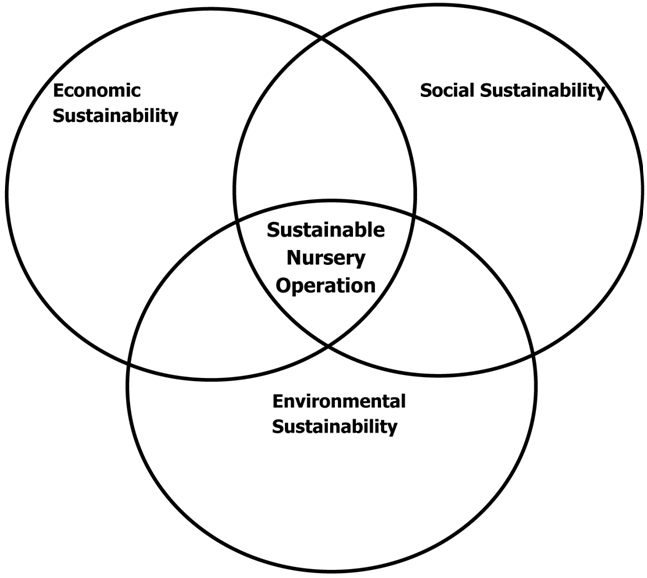The term sustainability is commonly used in discussing improvements in commercial nursery production, and the term sustainable practices appears commonly in scientific literature, press releases, and extension articles. It may refer to such diverse actions as using a new material for a root medium, upgrading to low-volume irrigation, or an improvement in nutrient management practices.
What is sustainability?
The most commonly used definition of sustainability is "meeting the needs of tomorrow without compromising the needs of the future," with the ending sometimes changed to "... of future generations."
What it often meant by sustainability is something like "doing things a little bit better," considering profitability, environmental impacts, and social concerns, all with an eye as to how today's production and business decisions influence the viability of the nursery operation in the future.
In this way, sustainable management practice in agriculture is often used to mean something similar to the standard terms best management practice or good management practice.
Profit, people, and planet
In agriculture, sustainability is often discussed as considering three spheres: economic sustainability, social sustainability, and environmental sustainability, or "Profit, people, and planet"

Venn diagram for sustainability in commercial nursery operations.
Adapted from K.A. Williams, D.J. Merhaut, and S.S. Mangiafico. 2018. "Integrating
Irrigation, Root Media, Fertilization, and Environmental Factors in Greenhouse
Production." In K.A. Williams, D.J. Merhaut, and S.S. Mangiafico (eds.).
Water, Root Media, and Nutrient Management for Greenhouse Crops.
University of California Agriculture and Natural Resources Press. Pub. 3551.
Economic sustainability might include:
- the efficient use of resources and labor
- production of profitable crops
- decisions to ensure both short-term and long-term profitability
- investing in equipment or knowledge that will pay off in the future
Social sustainability might include:
- the support of the local economy by the nursery
- the contribution of the operation to the agrarian character of the community
- production of crops that contribute beauty and enhance the lives of the end-consumers
- fair pay for employees and safe working conditions
Environmental sustainability might include:
- water conservation
- runoff prevention and wise stormwater management
- sustainable soil management, including preventing erosion
- efficient use of energy
Luckily, to a large extent sustainability in each of these spheres often supports sustainability in the other spheres. For example, the efficient use of water and fertilizers supports the economic viability of the operation, both because these inputs can be relatively expensive, and because their efficient use promotes better crops. In turn, the efficient use of water and fertilizers reduces the risk of nutrient runoff, thereby supporting the quality of local waterways. In this way, the local community benefits, both by having the contribution of an economically viable nursery operation and by having local water resources preserved.
The triple bottom line
In conclusion, the sustainability approach seeks to consider all production and business decisions in light of how they affect economic, social, and environmental outcomes, and with an eye toward long term effects and the long term viability of the nursery operation.

